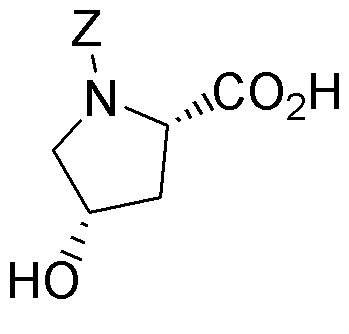Z-cis-L-4-hydroxyproline is widely utilized in research focused on:
- Pharmaceutical Development: This compound serves as a valuable building block in the synthesis of various pharmaceuticals, particularly in the creation of peptide-based drugs that target specific biological pathways.
- Cosmetic Formulations: Its unique properties make it an effective ingredient in skincare products, promoting skin hydration and elasticity, which is beneficial for anti-aging formulations.
- Biotechnology: Researchers use it in the development of biomaterials and tissue engineering applications, leveraging its ability to enhance cell adhesion and growth.
- Food Industry: As a food additive, it can improve the texture and stability of certain products, making it appealing for manufacturers looking to enhance product quality.
- Research on Collagen Synthesis: It plays a significant role in studies related to collagen production, which is crucial for understanding and treating connective tissue disorders.
General Information
Properties
Safety and Regulations
Applications
Z-cis-L-4-hydroxyproline is widely utilized in research focused on:
- Pharmaceutical Development: This compound serves as a valuable building block in the synthesis of various pharmaceuticals, particularly in the creation of peptide-based drugs that target specific biological pathways.
- Cosmetic Formulations: Its unique properties make it an effective ingredient in skincare products, promoting skin hydration and elasticity, which is beneficial for anti-aging formulations.
- Biotechnology: Researchers use it in the development of biomaterials and tissue engineering applications, leveraging its ability to enhance cell adhesion and growth.
- Food Industry: As a food additive, it can improve the texture and stability of certain products, making it appealing for manufacturers looking to enhance product quality.
- Research on Collagen Synthesis: It plays a significant role in studies related to collagen production, which is crucial for understanding and treating connective tissue disorders.
Documents
Safety Data Sheets (SDS)
The SDS provides comprehensive safety information on handling, storage, and disposal of the product.
Product Specification (PS)
The PS provides a comprehensive breakdown of the product’s properties, including chemical composition, physical state, purity, and storage requirements. It also details acceptable quality ranges and the product's intended applications.
Certificates of Analysis (COA)
Search for Certificates of Analysis (COA) by entering the products Lot Number. Lot and Batch Numbers can be found on a product’s label following the words ‘Lot’ or ‘Batch’.
*Catalog Number
*Lot Number
Certificates Of Origin (COO)
This COO confirms the country where the product was manufactured, and also details the materials and components used in it and whether it is derived from natural, synthetic, or other specific sources. This certificate may be required for customs, trade, and regulatory compliance.
*Catalog Number
*Lot Number
Safety Data Sheets (SDS)
The SDS provides comprehensive safety information on handling, storage, and disposal of the product.
DownloadProduct Specification (PS)
The PS provides a comprehensive breakdown of the product’s properties, including chemical composition, physical state, purity, and storage requirements. It also details acceptable quality ranges and the product's intended applications.
DownloadCertificates of Analysis (COA)
Search for Certificates of Analysis (COA) by entering the products Lot Number. Lot and Batch Numbers can be found on a product’s label following the words ‘Lot’ or ‘Batch’.
*Catalog Number
*Lot Number
Certificates Of Origin (COO)
This COO confirms the country where the product was manufactured, and also details the materials and components used in it and whether it is derived from natural, synthetic, or other specific sources. This certificate may be required for customs, trade, and regulatory compliance.


